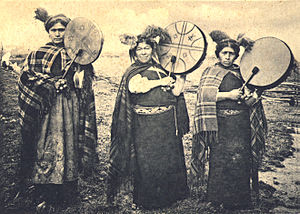
Femininity is a set of attributes, behaviors, and roles generally associated with women and girls. Femininity can be understood as socially constructed, and there is also some evidence that some behaviors considered feminine are influenced by both cultural factors and biological factors. To what extent femininity is biologically or socially influenced is subject to debate. It is conceptually distinct from both the female biological sex and from womanhood, as all humans can exhibit feminine and masculine traits, regardless of sex and gender.

The Mapuche is a group of native indigenous inhabitants of south-central Chile and southwestern Argentina, including parts of Patagonia. The collective term refers to a wide-ranging ethnicity composed of various groups who share a common social, religious, and economic structure, as well as a common linguistic heritage as Mapudungun speakers. Their homelands once extended from Choapa Valley to the Chiloé Archipelago and later spread eastward to Puelmapu, a land comprising part of the Argentine pampa and Patagonia. Today the collective group makes up over 80% of the indigenous peoples in Chile and about 9% of the total Chilean population. The Mapuche are concentrated in the Araucanía region. Many have migrated from rural areas to the cities of Santiago and Buenos Aires for economic opportunities.

Filipino shamans, commonly known as babaylan, were shamans of the various ethnic groups of the pre-colonial Philippine islands. These shamans specialized in communicating, appeasing, or harnessing the spirits of the dead and the spirits of nature. They were almost always women or feminized men. They were believed to have spirit guides, by which they could contact and interact with the spirits and deities and the spirit world. Their primary role were as mediums during pag-anito séance rituals. There were also various subtypes of babaylan specializing in the arts of healing and herbalism, divination, and sorcery.
The Nguruvilu is a creature originating from the Mapuche religion of the indigenous people inhabiting Chile. It is a river-dwelling creature that looks like a fox, with a long body, similar to a snake, and a long tail with fingernails that it uses like a claw.
Kalku or Calcu, in Mapuche mythology, is a sorcerer or witch who works with black magic and negative powers or forces. The essentially benevolent shamans are more often referred to as machi, to avoid confusion with the malevolent kalku. Its origins are in Mapuche tradition.
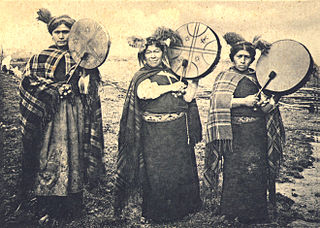
The religion of the indigenous Mapuche people of south-central Chile and southwestern Argentina is an extensive and ancient belief system. Legends and myths are common to the various groups that make up the Mapuche people. These myths tell of the creation of the world and the various deities and spirits that reside in it.
The wekufe, also known as huecufe, wekufü, watuku, huecufu, huecubo, huecubu, huecuvu, huecuve, huecovoe, giiecubu, güecubo, güecugu, uecuvu, güecufu; is an important type of harmful spirit or demon in Mapuche mythology. The word wekufe comes from the Mapudungun word wekufü meaning "demon, outside being".
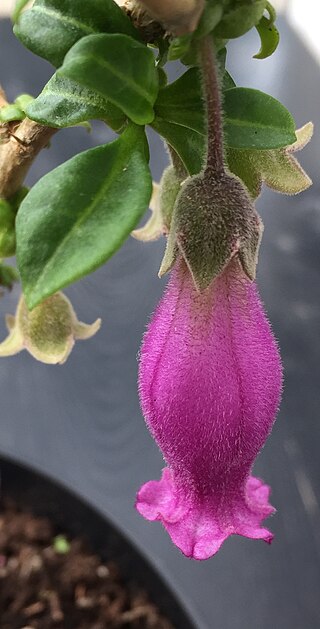
Latua pubiflora(Griseb.) Baillon, is the single species of the monotypic genus LatuaPhil., endemic to the coastal mountains of southern Chile. A shrub or small tree to 10 m in height, bearing attractive, magenta-to-red, hummingbird-pollinated flowers, it is extremely poisonous – hallucinogenic (deliriant) in smaller doses – due to tropane alkaloid content and is used by Chilean machi (shamans) of the Mapuche–Huilliche people in traditional medicine, as a poison and to enter trance states. Its elegant flowers and yellow tomato-like fruit are attractive enough to merit cultivation as an ornamental.
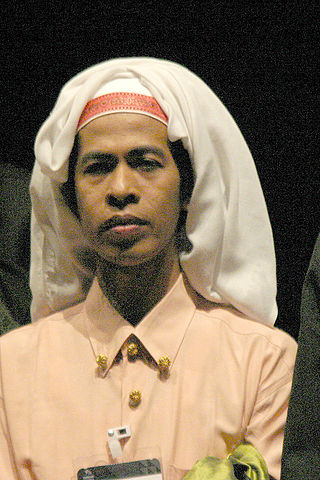
The Bugis people are the most numerous of the three major ethnic groups of South Sulawesi, Indonesia, with about 3 million people. Most Bugis are Muslim, but many pre-Islamic rites continue to be honoured in their culture, including the view that gender exists on a spectrum. Most Bugis converted from Animism to Islam in the early 17th century; small numbers of Bugis have converted to Christianity, but the influence of Islam is still very prominent in their society.

A rehue or kemukemu is a type of pillar-like sacred altar used by the Mapuche of Chile and Argentina in many of their ceremonies.
The spirit spouse is a widespread element of shamanism, distributed through all continents and at all cultural levels. Often, these spirit husbands/wives are seen as the primary helping spirits of the shaman, who assist them in their work, and help them gain power in the world of spirit. The relationships shamans have with their spirit spouses may be expressed in romantic, sexual, or purely symbolic ways, and may include gender transformation as a part of correctly pairing with their "spouse". Shamans report engaging with their spirit spouses through dreams, trance, and other ritual elements. In some cultures, gaining a spirit spouse is a necessary and expected part of initiation into becoming a shaman. Examples of spirit spouses may be seen in non-shamanic cultures as well, including dreams about Jesus Christ by nuns, who are considered to be "brides of Christ".

In the Philippines, a baklâ (Tagalog and Cebuano), bayot (Cebuano) or agî (Hiligaynon) is a person who was assigned male at birth and has adopted a gender expression that is feminine. They are often considered a third gender. Many bakla are exclusively attracted to men and some identify as women. The polar opposite of the term in Philippine culture is tomboy, which refers to women with a masculine gender expression. The term is commonly incorrectly applied to trans women.
Gender systems are the social structures that establish the number of genders and their associated gender roles in every society. A gender role is "everything that a person says and does to indicate to others or to the self the degree that one is either male, female, or androgynous. This includes but is not limited to sexual and erotic arousal and response." Gender identity is one's own personal experience with gender role and the persistence of one's individuality as male, female, or androgynous, especially in self-awareness and behavior. A gender binary is one example of a gender system.
The coloniality of power is a concept interrelating the practices and legacies of European colonialism in social orders and forms of knowledge, advanced in postcolonial studies, decoloniality, and Latin American subaltern studies, most prominently by Anibal Quijano. It identifies and describes the living legacy of colonialism in contemporary societies in the form of social discrimination that outlived formal colonialism and became integrated in succeeding social orders. The concept identifies the racial, political and social hierarchical orders imposed by European colonialism in Latin America that prescribed value to certain peoples/societies while disenfranchising others.
Mapuche flag is each of the flags used as an emblem and symbol of the Mapuche Nation and the Mapuche communities and organizations in Chile and Argentina. There are several different flags representing the Mapuche communities and territories.
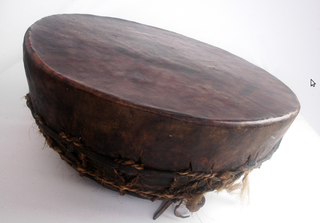
The cultrun is a percussion instrument used by the Mapuche in Chile and Argentina.
Mapuche medicine is the system of medical treatment historically used by the Mapuche people of southern Chile. It is essentially magical-religious in nature, believing disease to be caused by supernatural factors such as spells and curable by treatments based on rituals, thermal waters and herbs. Knowledge of medicinal herbs is one of the best-known elements of Mapuche medicine and is still used today.
The history of lesbian, gay, bisexual and transgender people (LGBT) in Argentina is shaped by the historic characterisation of non-heterosexuality as a public enemy: when power was exercised by the Catholic Church, it was regarded as a sin; during the late 19th and early 20th centuries, when it was in the hands of positivist thought, it was viewed as a disease; and later, with the advent of civil society, it became a crime.
Ana Mariella Bacigalupo is a Peruvian anthropologist. She is a full professor at the State University of New York at Buffalo and has previously taught throughout the USA and in Chile. Her research primarily focuses on the shamans or machis of the Mapuche community of Chile, and the ways shamanic practices and beliefs are affected by and influence communal experiences of state power, mythical history, ethics, gender, justice, and identity.

Francisca Linconao Huircapán, also known as Machi Linconao, is a machi and human rights activist in Chile. She became the first Indigenous rights defender in Chile to successfully invoke the 1989 Indigenous and Tribal Peoples Convention when she sued to stop a company from logging a forest adjacent to her community. In 2021, she was elected as a representative of the Mapuche people to the Chilean Constitutional Convention election.
